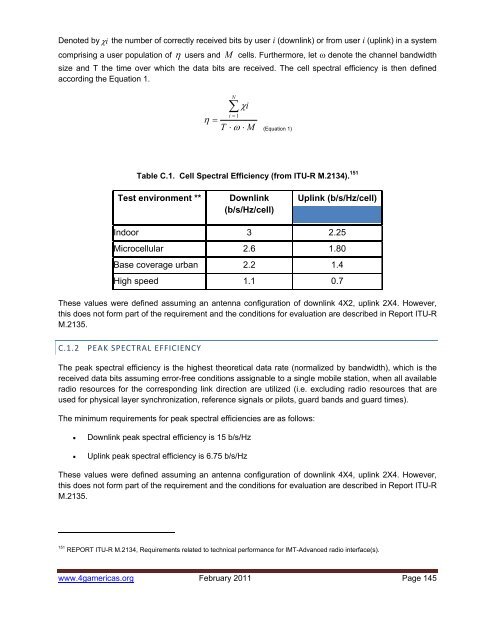Create successful ePaper yourself
Turn your PDF publications into a flip-book with our unique Google optimized e-Paper software.
Denoted by � i the number of correctly received bits by user i (downlink) or from user i (uplink) in a system<br />
comprising a user population of � users and M cells. Furthermore, let � denote the channel bandwidth<br />
size and T the time over which the data bits are received. The cell spectral efficiency is then defined<br />
according the Equation 1.<br />
N<br />
�<br />
�<br />
�i<br />
i 1<br />
� �<br />
T � � � M<br />
(Equation 1)<br />
Table C.1. Cell Spectral Efficiency (from ITU-R M.2134). 151<br />
Test environment ** Downlink<br />
(b/s/Hz/cell)<br />
Uplink (b/s/Hz/cell)<br />
Indoor 3 2.25<br />
Microcellular 2.6 1.80<br />
Base coverage urban 2.2 1.4<br />
High speed 1.1 0.7<br />
These values were defined assuming an antenna configuration of downlink 4X2, uplink 2X4. However,<br />
this does not form part of the requirement and the conditions for evaluation are described in Report ITU-R<br />
M.2135.<br />
C.1.2 PEAK SPECTRAL EFFICIENCY<br />
The peak spectral efficiency is the highest theoretical data rate (normalized by bandwidth), which is the<br />
received data bits assuming error-free conditions assignable to a single mobile station, when all available<br />
radio resources for the corresponding link direction are utilized (i.e. excluding radio resources that are<br />
used for physical layer synchronization, reference signals or pilots, guard bands and guard times).<br />
The minimum requirements for peak spectral efficiencies are as follows:<br />
� Downlink peak spectral efficiency is 15 b/s/Hz<br />
� Uplink peak spectral efficiency is 6.75 b/s/Hz<br />
These values were defined assuming an antenna configuration of downlink 4X4, uplink 2X4. However,<br />
this does not form part of the requirement and the conditions for evaluation are described in Report ITU-R<br />
M.2135.<br />
151 REPORT ITU-R M.2134, Requirements related to technical performance for IMT-Advanced radio interface(s).<br />
www.4gamericas.org February 2011 Page 145

















